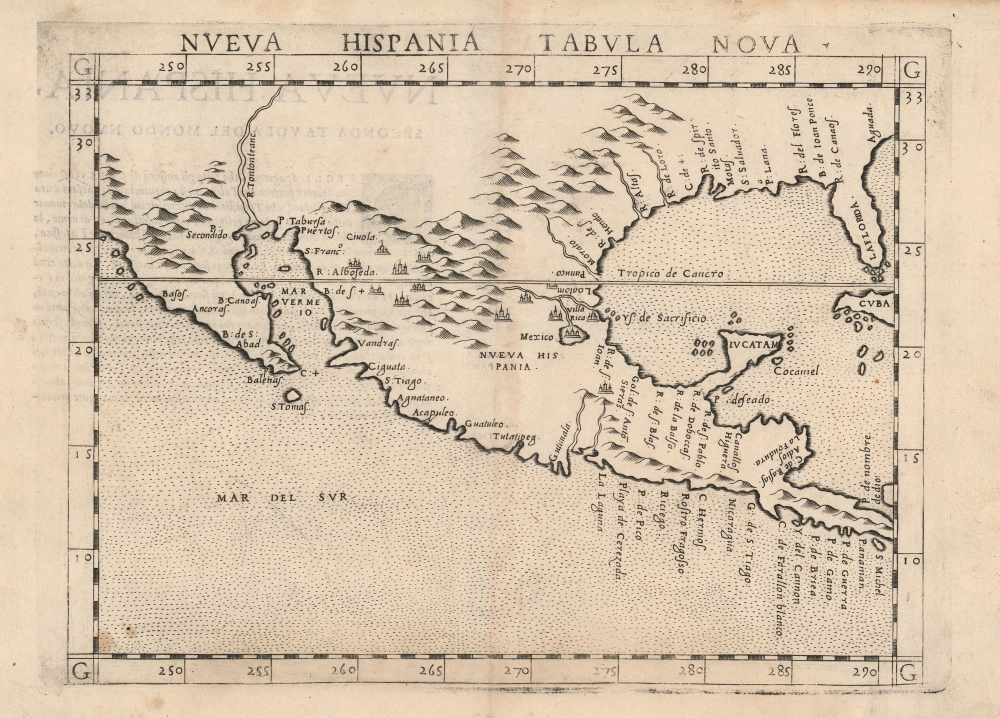This item has been sold, but you can get on the Waitlist to be notified if another example becomes available, or purchase a digital scan.
1574 Ruscelli Map of Mexico, California, Florida and the Gulf of Mexico
NuevaHispania-ruscelli-1561
Title
1561 (undated) 7.5 x 9.5 in (19.05 x 24.13 cm) 1 : 19000000
Description
The Scope
The west coast is depicted, with a peninsular California, from twenty-five degrees north down to the coast of Panama; the east embraces Florida, all of the Gulf of Mexico, and names the Nombre de Dios on the Caribbean coast of Panama. The western part of Cuba appears and is named. Yucatan is illustrated as a peninsula, a material improvement on the 1548 Gastaldi which portrayed it as an island. Inland, Mexico City is named, along with the legendary Civola.Publication History and Census
This map was first published by Girolamo Ruscelli for the 1561 first edition of his Geography of Claudius Ptolemy, La Geografia di Claudio Tolomeo. It was engraved by Giulio Sanuto for inclusion in the 1561 Ruscelli Ptolemy, and remained in print for the various editions of the work. The maps of this edition were engraved two-to-a-plate, and consequently the platemark runs off the edge of the sheet at top on first state examples of the map. By the time this 1574 edition was printed, the plates had been cut in two. Thus, later examples such as the present one exhibit a platemark all the way around. The engraving was also retooled in 1574, with crosshatching added to the graduation marks. A third state appeared in 1598 with several significant geographical revisions, including the addition of a ship, along with the placenames 'Siera Nevad' and 'Calmifor'. The 1598 issue also renames 'Mar Del Sur' as 'Mare Pacificum,' and names the Gulf of Mexico. This map comes to the market from time to time and is well represented in institutional collections as a staple of early North America cartography.CartographerS
Girolamo Ruscelli (1500 - 1566) was an Italian polymath, humanist, editor, and cartographer active in Venice during the early 16th century. Born in Viterbo, Ruscelli lived in Aquileia, Padua, Rome and Naples before relocating to Venice, where he spent much of his life. Cartographically, Ruscelli is best known for his important revision of Ptolemy's Geographia, which was published posthumously in 1574. Ruscelli, basing his work on Gastaldi's 1548 expansion of Ptolemy, added some 37 new "Ptolemaic" maps to his Italian translation of the Geographia. Ruscelli is also listed as the editor to such important works as Boccaccio's Decameron, Petrarch's verse, Ariosto's Orlando Furioso, and various other works. In addition to his well-known cartographic work many scholars associate Ruscelli with Alexius Pedemontanus, author of the popular De' Secreti del R. D. Alessio Piemontese. This well-known work, or "Book of Secrets" was a compilation of scientific and quasi-scientific medical recipes, household advice, and technical commentary on a range of topics that included metallurgy, alchemy, dyeing, perfume making. Ruscelli, as Alexius, founded a "Academy of Secrets," a group of noblemen and humanists dedicated to unearthing "forbidden" scientific knowledge. This was the first known experimental scientific society and was later imitated by a number of other groups throughout Europe, including the Accademia dei Secreti of Naples. More by this mapmaker...
Giulio Sanuto (fl. 1540 – 1580) was a Venetian engraver. He was born the illegitimate son of Cavaliere Francesco di Angelo Sanuto; With his brother, the cartographer and scientific instrument maker Livio Sanuto (1520 – 1576) he produced an array of some of the most important geographical works produced in Venice during the second half of the sixteenth century. These included a 27-inch globe and the 1588 12-sheet atlas, Geografia della Africa. Giulio's career is singluar among Venice's engraves in that it appears to have been equally based on artistic, figurative work as well as his cartographic works. Giulio is more broadly known for a small but sought-after selection of decorative engravings; no more than twelve of these can be attributed confidently to him, including the monumental Apollo and Marsyas, measuring over 1.30 meters wide. Whilst Sanuto's engravings were generally based upon the designs of other artists, his work was both ambitious and grand, and he often signed these works. Learn More...
Source
- 1561 La Geographia di Claudio Tolomeo Alessandrino, Italian. Venice, Vincenzo Valgrisi.
- 1562 Geographia Cl. Ptolemaei Alexandrini, Latin. Venice, Vincenzo Valgrisi.
- 1564 La Geographia di Claudio Tolomeo Alessandrino, Italian. Venice, Giordano Ziletti.
- 1564 Geographia Cl. Ptolemaei Alexandrini, Latin. Venice, Giordano Ziletti.
- 1574 La Geographia di Claudio Tolomeo Alessandrino, Italian. Venice, Giordano Ziletti.
- 1598 Geographia di Claudio Tolomeo Alessandrino, Italian. Venice, heirs of Melchoir Sessa.
- 1599 Geographia di Claudio Tolomeo Alessandrino, Italian. Venice, heirs of Melchoir Sessa.

